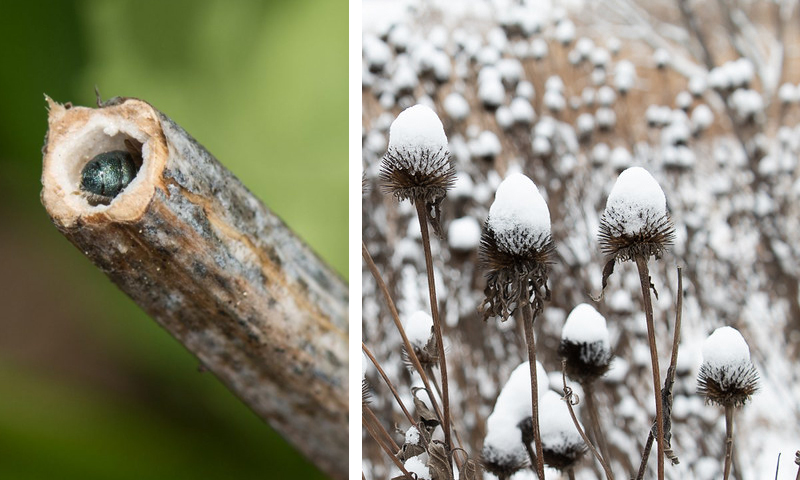
Photo credits: Left – Heather Holm (Ceratina); Right – Cydney Ross (Coneflowers in winter)
By Chris Cardwell, Deep Roots’ Program Manager
How do I prepare my native plants for the winter? I have a Swamp Milkweed which is very well established. I also have Tickweed (coreopsis), Purple Coneflowers and Black-Eyed Susan Coneflowers. I read online that I should cut the Swamp Milkweed back to six inches with a pair of sterilized pruners and leave it that way for the winter. That seems to me to be pretty unprotected. I also wasn’t sure if I just cut back the Coneflowers and Tickweed. Thanks,
A.) Preparing your native plant landscapes for winter can vary widely depending on your gardening goals, HOA restrictions, and the diversity of your landscape’s habitat for overwintering wildlife. A fair percentage of native bees (up to 30%) actually nest above ground, either in cavities and crevices in trees or downed limbs, or in the hollowed woody stems of perennial plants – and Swamp Milkweed is just such an ideal plant to leave the stems for such habitat. We encourage leaving as much of the stems of milkweed as you’re able to – a couple feet, up to the entire stalk if you can, and if it suits your aesthetic goals for the garden space you’re working in. If you must cut them, a second-best alternative is to bundle them and place them in a somewhat protected place in your yard – where they can still be utilized, and the next growing season’s bees will emerge near the food sources your native plants are providing. According to Tufts University’s Pollinator Initiative, stems from multiple seasons of growth should all be left intact to support the broadest range of stem-nesting bees that will nest, lay eggs, and re-emerge at all different times of year, and after varying lengths of incubation as eggs and larvae. With that said, prune the stems back to your preferred height once all the leaves have dropped, and if you’d like to add some leaf mulch, or a layer of compost around the root crown of the plant, you’ll provide just that little extra layer of protection from frost damage through the coldest days of winter. Learn more
Now as for coneflowers (Echinacea), black eyed susans (Rudbeckia), and tickseed (Coreopsis), I’d recommend a few different approaches: the stems of black eyed susans and coreopsis aren’t typically thick enough for insects to nest in, but they can be prolific self-seeders if left to disperse after the growing season. If you have space for them to spread out and make more plants, then you can leave them to drop, or wait for the seeds to ripen, cut the stems back and scatter them in empty spots of your garden beds. But as for coneflowers, their seeds are a critical food source for several bird and mammal species, such as finches, that will stick around the KC area through winter. Leaving the dried-out coneflowers standing upright will send a signal to this wildlife that dinner is ready, and your yard is the hot spot for a winter buffet. They also provide some beautiful winter interest with their texture and deep brown hues – especially once that first snow begins to light on their seed heads. In short, native landscapes provide critical resources for wildlife in all seasons and anytime it’s possible to do so you should “Leave them Standing!”
For anyone interested in more in-depth learning on how to create ideal habitat for native bees, or pollinator support in general – great news! Renowned author, presenter, and educator Heather Holm will be one of our amazing speakers at Plan It Native 2024 right here in Kansas City! Our highly anticipated conference returns in-person, February 15th and 16th at Kaufmann Conference Center and Anita Gorman Discovery Center. Registration will be open soon – so Save The Date and stay tuned!







